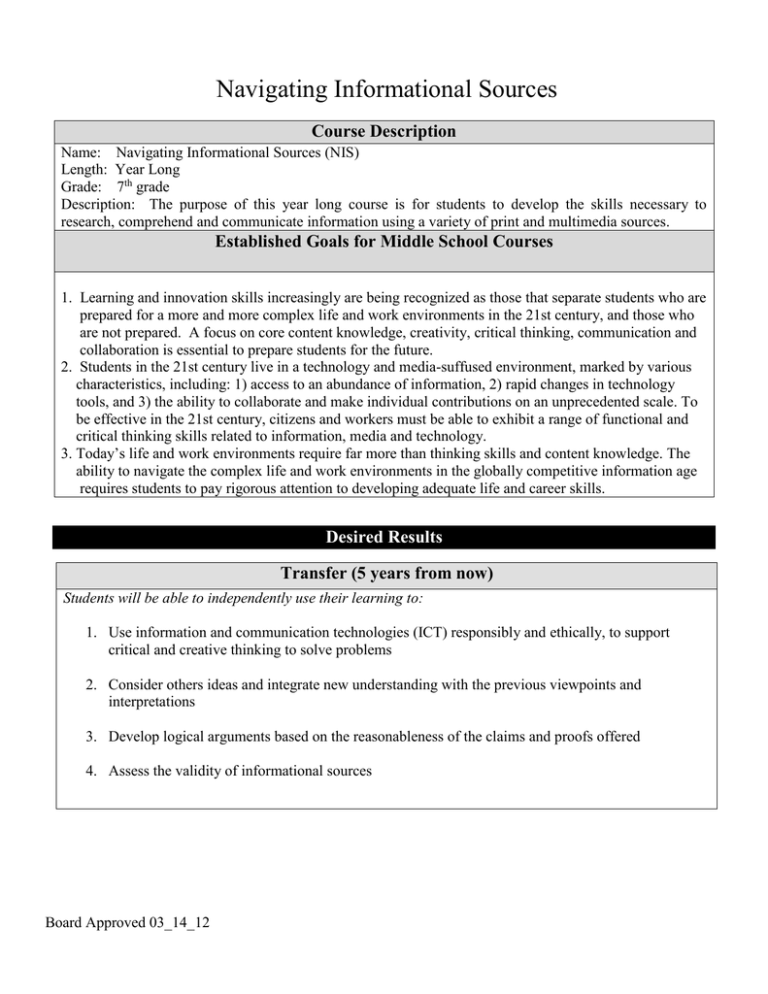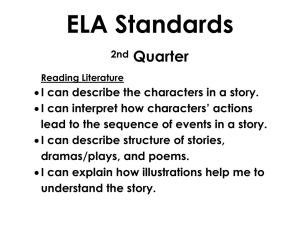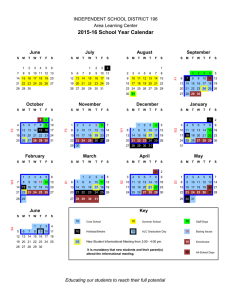Navigating Informational Sources Course Description
advertisement

Navigating Informational Sources Course Description Name: Navigating Informational Sources (NIS) Length: Year Long Grade: 7th grade Description: The purpose of this year long course is for students to develop the skills necessary to research, comprehend and communicate information using a variety of print and multimedia sources. Established Goals for Middle School Courses 1. Learning and innovation skills increasingly are being recognized as those that separate students who are prepared for a more and more complex life and work environments in the 21st century, and those who are not prepared. A focus on core content knowledge, creativity, critical thinking, communication and collaboration is essential to prepare students for the future. 2. Students in the 21st century live in a technology and media-suffused environment, marked by various characteristics, including: 1) access to an abundance of information, 2) rapid changes in technology tools, and 3) the ability to collaborate and make individual contributions on an unprecedented scale. To be effective in the 21st century, citizens and workers must be able to exhibit a range of functional and critical thinking skills related to information, media and technology. 3. Today’s life and work environments require far more than thinking skills and content knowledge. The ability to navigate the complex life and work environments in the globally competitive information age requires students to pay rigorous attention to developing adequate life and career skills. Desired Results Transfer (5 years from now) Students will be able to independently use their learning to: 1. Use information and communication technologies (ICT) responsibly and ethically, to support critical and creative thinking to solve problems 2. Consider others ideas and integrate new understanding with the previous viewpoints and interpretations 3. Develop logical arguments based on the reasonableness of the claims and proofs offered 4. Assess the validity of informational sources Board Approved 03_14_12 The Essential Understandings for Navigating Informational Sources Students will understand the following concepts: 1. Use multiple resources including technology to plan, design, and execute real world problems 2. Ideas can influence individuals to behave differently and shape events, or individuals’ behavior can influence a change in ideas or shape events 3. Multiple perspectives can characterize the same event differently 4. Literature can reflect a period of time with license to mix fact and fiction 5. Questions should lead to further research and additional questions Essential Questions for Navigating Informational Sources 1. Why is it important to use multiple sources when researching? 2. What is a credible source? 3. How do I generate questions for a research project? 4. How do I distinguish between fact and opinion? 5. How can I form a claim and defend it? 6. How do I synthesize information? 7. How do I use information to answer questions and solve problems? 8. How do I select an appropriate way to share my information? 9. How do I determine relevant information and exhaust all relevant sources? Board Approved 03_14_12 Essential Standards: Knowledge and Skills for Navigation Informational Sources K Students will know, understand and be able to: 1. Determine the central ideas or information of a primary or secondary source; provide an accurate summary of the source distinct from prior knowledge or opinions. 2. Cite several pieces of textual evidence to support analysis of what the text says explicitly as well as inferences drawn from the text. 3. Cite specific textual evidence to support analysis of primary and secondary sources. 4. Analyze the interactions between individuals, events, and ideas in a text (e.g. how ideas influence individual or events, or how individuals influence ideas or events) 5. Analyze the structure an author uses to organize a text, including how the major sections contribute to the whole and to the development of the ideas. (text structure) 6. Identify aspects of a text that reveal an author’s point of view or purpose (e.g. loaded language, inclusion or avoidance of particular facts). 7. Compare and contrast a text to an audio, video, or multimedia version of the texts, analyzing each medium’s portrayal of the subject (e.g., how the delivery of a speech affects the impact of the words). 8. Integrate visual information (e.g. charts, graphs, photographs, videos, or maps) with other information in print and digital texts. 9. Trace and evaluate the argument and specific claims in a text, assessing whether the reasoning is sound and the evidence is relevant and sufficient to support the claims. 10. Compare and contrast a fictional portrayal of a time, place, or character and a historical account of the same period as a means of understanding how authors of fiction use or alter history. 11. Analyze how two or more authors writing about the same topic shape their presentations of key information by emphasizing different evidence or advancing different interpretation of facts. (bias) 12. Compare and contrast the information gained from experiments, simulations, video, or multimedia sources with that gained from reading a text on the same topic. 13. Write arguments focused on discipline-specific content. 14. Follow precisely a multistep procedure when carrying out experiments, taking measurements, or performing technical tasks. 15. Write informative/explanatory texts, including the narration of historical events, scientific procedures/experiments, or technical processes. (scaffolded lab write up) Board Approved 03_14_12 16. Use technology, including the Internet, to produce and publish writing and link to and cite sources as well as to interact and collaborate with others, including linking to and citing sources. 17. Use technology, including the Internet, to produce and publish writing and present the relationships between information and ideas clearly and efficiently. 18. Conduct short research projects to answer a question (including self-generated question), drawing on several sources and generating additional related, focused questions that allow for multiple avenues of exploration. 19. Gather relevant information from multiple print and digital sources, using search terms effectively; assess the credibility and accuracy of each source; and quote or paraphrase the data and conclusions of others while avoiding plagiarism and following a standard format for citation. 20. Draw evidence from informational texts to support analysis and reflection, and research. Assessment Evidence Performance Tasks Performance Tasks: 1. Produce one extended project that uses research to address a significant topic, problem or issue 2. Collaborate with others related to researching both sides of an issue 3. Research a variety of sources to obtain information 4. Produce a project that has a self-selected topic 5. Support a “big idea” question with appropriate sources (e.g. What event has had an impact either locally, globally or nationally through multimedia?) 6. Present their findings in a variety of modes in informal and more formal argumentative or explanatory contexts, either in writing or orally or in multi-media. 7. The students select appropriate digital tools to assemble, evaluate and utilize information. Other Evidence: (e.g. tests, quizzes, prompts, work samples observations) 1. Use a graphic organizer to compare and contrast information 2. Complete a Double entry journal--authors purpose, fact/opinion 3. Read or view an informational source and identify the main idea and develop a summary 4. Complete a reflection page Board Approved 03_14_12 5. Use a T-Chart for fact an opinion (look for key words, etc) 6. Develop a quality research question(s) related to a topic 7. Identify the type of text (e.g. problem-solution, cause & effect, sequence, description, argumentative) 8. Create an annotated works cited (e.g. using Noodle Tools) Student Self-Assessment and Reflection: 1. Completion of 3-2-1 exit slips 2. Do Journal Entries online or use a class blog 3. Use of a Student Rubric to assess projects References The Common Cores Standards for English Language Arts and Literacy in History/Social Studies, Science, and Technical Subjects (CCSS) http://www.corestandards.org Board Approved 03_14_12 Board Approved 03_14_12



